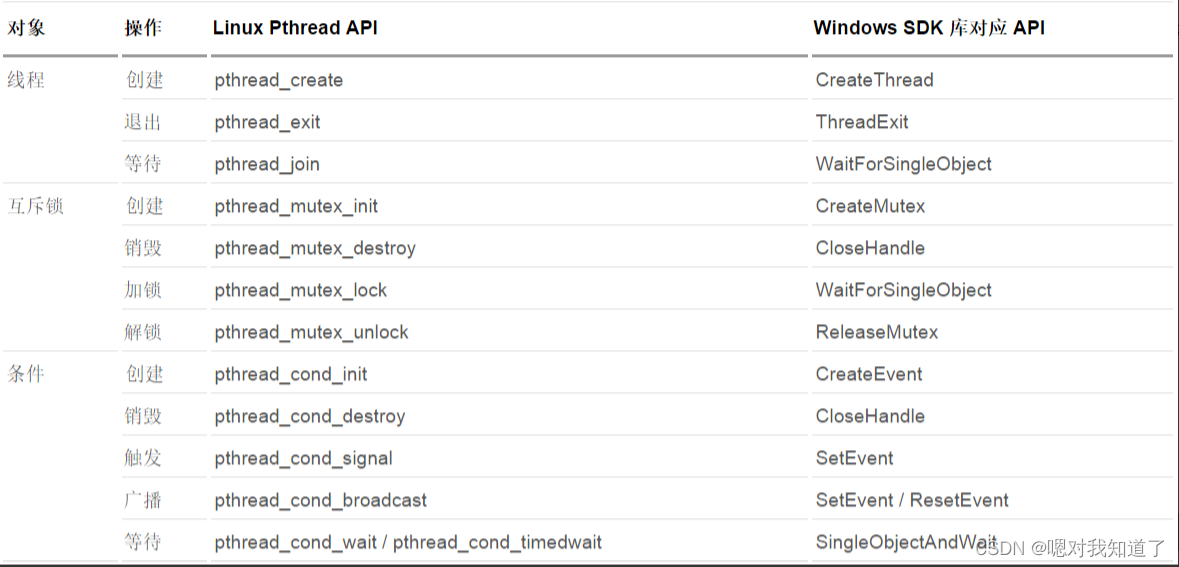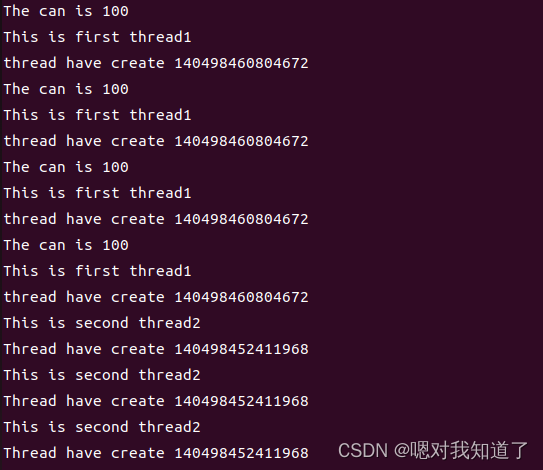文章目录
前言
埋头苦干是第一,发白才知智叟呆。勤能补拙是良训,一分辛苦一分才。——华罗庚
一、线程是什么?和进程有什么区别?
进程:是指⼀个内存中运⾏的应⽤程序,每个进程都有⼀个独⽴的内存空间,⼀个应⽤程序可以同时运⾏多个进程;
进程也是程序的⼀次执⾏过程,是系统运⾏程序的基本单位;系统运⾏⼀个程序即是 ⼀个进程从创建、运⾏到消亡的过程。
(拷贝父进程的内存空间,拥有独立的内存空间,消耗资源大,效率低)
线程:线程是进程中的⼀个执⾏单元,负责当前进程中程序的执⾏,⼀个进程中⾄少有⼀个线程。
⼀个进程中是可以有多个线程的,这个应⽤程序也可以称之为多线程程序。(共享内存资源,崩溃后整个线程会一起崩溃)
多线程开发在 Linux 平台上已经有成熟的 pthread 库支持。其涉及的多线程开发的最基本概念主要包含三点:线程,互斥锁,条件。其中,
线程操作又分线程的创建,退出,等待 3 种。互斥锁则包括 4 种操作,分别是创建,销毁,加锁和解锁。条件操作有 5 种操作:创建,销毁,触发,广播和等待。
其他的一些线程扩展概念,如信号灯等

二、线程的创建
1.原型:
#include <pthread.h>
int pthread_create(pthread_t *restrict tidp,const pthread_attr_t *restrict attr,void *(*start_rtn)(void *),void *restrict arg);
tidp 指向的是新创建的线程ID
attr 定制不同属性线程
star_rtn 函数从该地址开始运行
成功返回0,失败返回错误编码;
int pthread_exit(void *rval_prt); //线程的退出
int pthread_join(pthread_t thread,void **rval_ptr); //线程的等待
成功返回0,失败返回错误的编号
int pthread_detach(pthread_t thread); //线程脱离
pthread_t pthread_self(void); //获取线程的ID
int pthread_equal(pthread_t tid1,pthread_t tid2); //相等返回非0的数,否则返回0
2.代码分析
代码如下(示例):
#include <stdio.h>
#include <pthread.h>
#include <stdlib.h>
#include <unistd.h>
void *fun1(void *arg)
{
static int pet = 10;
printf("%ld thread is create \n",(unsigned long)pthread_self());
printf("param is %d\n",*((int *)arg));
pthread_exit((void *)&pet);
}
int main()
{
int ret;
int param = 100;
int *repet = NULL;
pthread_t t1;
ret = pthread_create(&t1,NULL,fun1,(void *)¶m);
if(ret != 0){
printf("thread create error\r\n");
exit(-1);
}
// sleep(2);
pthread_join(t1,(void **)&repet);
printf("The pthread is %d\n",*repet);
return 0;
}
三、互斥量加锁实验
1.互斥量的概述:
1.互斥:互斥锁,在同一时刻只能有一个执行流访问临界资源
2.互斥锁是一个阻塞接口,使用互斥锁来保证互斥属性,底层是互斥量,互斥量的本质是一个计数器,有0和1
3.计数器的值为:
0:无法获取互斥锁,即临界资源无法访问,并阻塞在加锁操作
1:可以获取互斥锁,互斥锁成功返回,并访问临界资源
#include <stdio.h>
#include <unistd.h>
#include <pthread.h>
#include <stdlib.h>
int g_data = 10;
pthread_mutex_t mutex; //创建互斥锁
void *fun1(void *arg)
{
pthread_mutex_lock(&mutex);
for(int i=0;i < 4;i++){
printf("The can is %d\n",*(int *)arg);
printf("This is first thread1\n");
printf("thread have create %ld\n",(unsigned long)pthread_self());
sleep(1);
}
pthread_mutex_unlock(&mutex);
}
void *fun2(void *arg)
{
sleep(1);
(void)arg;
pthread_mutex_lock(&mutex);
for(int j=0;j<3;j++){
printf("This is second thread2\n");
printf("Thread have create %ld\n",(unsigned long)pthread_self());
}
pthread_mutex_unlock(&mutex);
}
int main()
{
// int ret1,ret2;
int param = 100;
pthread_mutex_init(&mutex,NULL);
pthread_t t1;
pthread_t t2;
if(pthread_create(&t1,NULL,fun1,(void *)¶m) != 0){
printf("thread create error\n");
exit(-1);
}
if(pthread_create(&t2,NULL,fun2,NULL) != 0){
printf("thread create error\n");
exit(-1);
}
pthread_join(t1,NULL);
pthread_join(t2,NULL);
pthread_mutex_destroy(&mutex);
return 0;
}
2.执行结果

四、互斥量加锁变成死锁
1.概述
一个执行流拿到锁资源,但没有释放就退出,会导致其它想要获取该互斥锁的执行流陷入阻塞等待,这种情况称为死锁。
当期执行流已经占用了一个互斥锁1,还申请新的互斥锁2,被阻塞,并且互斥锁1是无法解锁的(环型死锁)
五、线程条件控制实现线程的同步
1.概述:
条件变量是线程另一可用的同步机制。条件变量给多个线程提供了一个会合的场所。
条件变量与互斥量一起使用时,允许线程以无竞争的方式等待特定的条件发生。
条件本身是由互斥量保护的。线程在改变条件状态前必须首先锁住互斥量,
其他线程在获得互斥量之前不会察觉到这种改变,因为必须锁定互斥量以后才能计算条件。
2.代码实现:
#include <stdio.h>
#include <unistd.h>
#include <pthread.h>
#include <stdlib.h>
#include <stdlib.h>
int g_data = 0;
pthread_mutex_t mutex; //创建互斥锁
pthread_cond_t cond;
void *fun1(void *arg) //线程1的入口函数
{
static int cnt = 0;
while(1){
pthread_cond_wait(&cond,&mutex);
printf("The can is %d\n",*(int *)arg);
printf("This is first thread1\n");
printf("thread have create %ld\n",(unsigned long)pthread_self());
printf("T1 timeout ==================================\n");
printf("In fun1 data :%d\n",g_data);
g_data = 0;
if(cnt++ == 10){
printf("All work success\r\n");
exit(0);
}
sleep(1);
}
}
void *fun2(void *arg) //线程2的入口函:
{
pthread_mutex_lock(&mutex);
(void)arg;
printf("This is second thread2\n");
printf("Thread have create %ld\n",(unsigned long)pthread_self());
while(1){
sleep(1);
g_data++;
printf("In fun2 data :%d\n",g_data);
if(g_data == 3){
pthread_cond_signal(&cond);
pthread_mutex_unlock(&mutex);
}
}
}
int main()
{
int param = 100;
pthread_mutex_init(&mutex,NULL);
pthread_cond_init(&cond,NULL);
pthread_t t1;
pthread_t t2;
if(pthread_create(&t1,NULL,fun1,(void *)¶m) != 0){
printf("thread create error\n");
exit(-1);
}
if(pthread_create(&t2,NULL,fun2,NULL) != 0){
printf("thread create error\n");
exit(-1);
}
pthread_join(t1,NULL);
pthread_join(t2,NULL);
pthread_mutex_destroy(&mutex);
pthread_cond_destroy(&cond);
return 0;
}






















 244
244











 被折叠的 条评论
为什么被折叠?
被折叠的 条评论
为什么被折叠?








